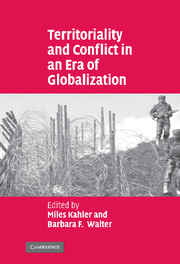Book contents
- Frontmatter
- Contents
- List of figures
- List of tables
- List of contributors
- Acknowledgments
- 1 Territoriality and conflict in an era of globalization
- Part I Territorial attachment and detachment
- 2 Bounded communities: territoriality, territorial attachment, and conflict
- 3 On giving ground: globalization, religion, and territorial detachment in a Papua New Guinea society
- 4 The resilience of territorial conflict in an era of globalization
- 5 Diasporas and homeland conflict
- Part II Territorial stakes and violent conflict
- Part III Territorial regimes in an era of globalization
- Conclusion
- References
- Index
4 - The resilience of territorial conflict in an era of globalization
Published online by Cambridge University Press: 22 September 2009
- Frontmatter
- Contents
- List of figures
- List of tables
- List of contributors
- Acknowledgments
- 1 Territoriality and conflict in an era of globalization
- Part I Territorial attachment and detachment
- 2 Bounded communities: territoriality, territorial attachment, and conflict
- 3 On giving ground: globalization, religion, and territorial detachment in a Papua New Guinea society
- 4 The resilience of territorial conflict in an era of globalization
- 5 Diasporas and homeland conflict
- Part II Territorial stakes and violent conflict
- Part III Territorial regimes in an era of globalization
- Conclusion
- References
- Index
Summary
Introduction
The analysis of territory as a changing focus for political power has moved beyond the exclusive confines of the geographic discipline during the past decade. The study of territory and borders now constitutes a multidisciplinary research focus, drawing in political scientists, sociologists, anthropologists, and legal experts, as they seek to understand the role of territory in the contemporary globalized world (Coakley 1993; Diehl 1999b; Dijkink and Knippenberg 2001). The globalist position argues that we are moving into a deterritorialized and borderless world. At the same time, the existence of ethnoterritorial conflicts reminds us that many groups continue to lay claim to specific pieces of territory in what could be described as a primordial, pre-modern, fashion. This raises questions concerning the functions and role of territory as part of the changing world political map. This chapter seeks to examine this resilience of territory as a factor of major political and functional significance, focusing on such contemporary cases as Israel–Palestine and the Balkans.
The territorial discourse within political geography has experienced a renaissance during the past two decades (Agnew 2000; Paasi 2002). An important framework for understanding the role of territory as a key factor in the political organization of space, and as a basis for the re-emergence of political geography as a bona fide discipline after three decades of shunning due to its “guilt by association” with the German school of Geopolitik (Newman 2002a),was provided by Edward Soja in what proved to be a seminal paper published by the Association of American Geographers in 1971 (Soja 1971).
- Type
- Chapter
- Information
- Territoriality and Conflict in an Era of Globalization , pp. 85 - 110Publisher: Cambridge University PressPrint publication year: 2006
- 29
- Cited by



